An Illustrated History of Old Sutton in St Helens, Lancashire
Part 10 (of 95 parts) - History of Religion in Sutton Part 3
Also see: Religion Part 1 | Part 2 (St. Anne’s) | Part 4 (Chapels) | Photo Album
Researched and Written by Stephen R. Wainwright ©MMXX Contact Me
Also see: Part 1 | Part 2 (St. Anne’s) | Part 4 (Chapels)
Researched & Written by Stephen Wainwright ©MMXX
Old Sutton in St Helens
St. Theresa of the Child Jesus, Sutton Manor
St. Theresa of the Child Jesus in Sutton Manor is another remarkable Roman Catholic church. Although the mission dates back almost a hundred years, the present church was only completed in 1959, some 28 years after the foundation stone was laid. It was the dream and passion of Father Ralph Holden who wished to build a basilica dedicated to the newly-canonised Thérèse of Lisieux. Influenced by the large numbers of pilgrims who were making their way to St. Anne’s for 'Dominic Sundays', Fr. Holden hoped that similar numbers would be drawn to his church. However there were many setbacks and a beautiful, if somewhat less grandiose place of worship, was finally opened some seven years after the death of its founding priest.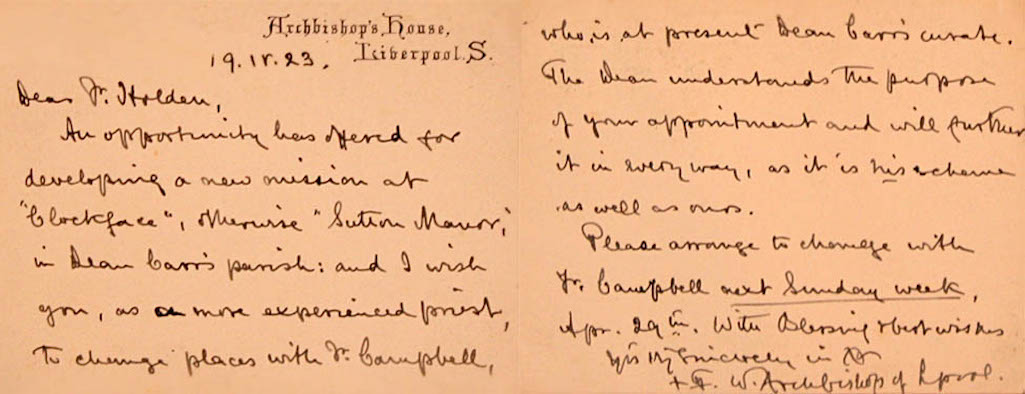
Both sides of a card sent to Fr. Holden in 1923 from the Very Rev. Frederick William Keating, Archbishop of Liverpool

A card sent to Fr. Holden in 1923 from the Archbishop of Liverpool

Card sent to Fr. Holden in 1923
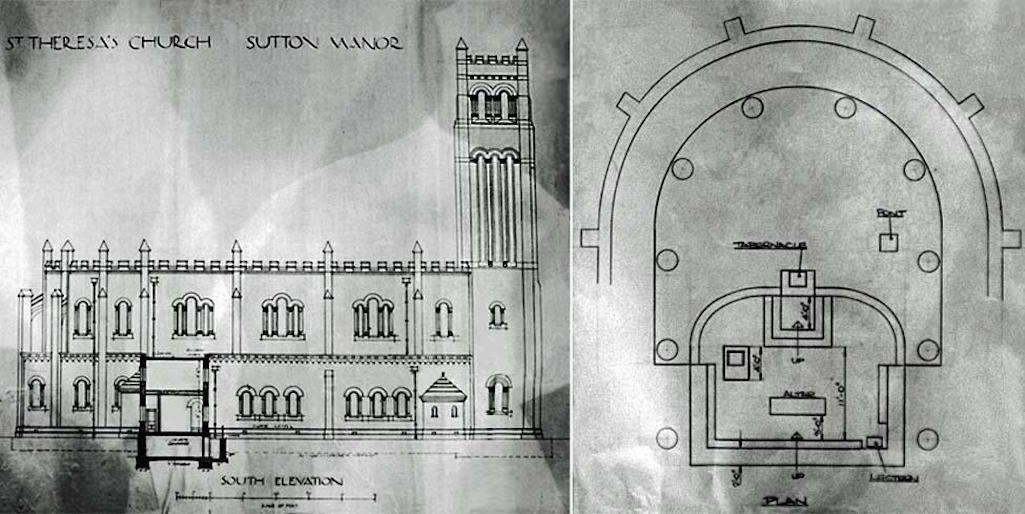
Left: Original plan for St.Theresa's; Right: Convent sanctuary plan with altar, tabernacle, font and lectern marked

Left: Original plan for St.Theresa's RC church in Sutton Manor; Right: Convent sanctuary plan with altar, tabernacle, font and lectern all marked

Original plans for St.Theresa's Church
However the 1928 Ordnance Survey map reveals the school adjacent to and to the west of the church, on the opposite side of the street. It's likely that the school building was opened here in 1926 but soon became inadequate and so a new building was constructed across the way. The date plaque was then probably transferred to the new building. The old building was still used as a school for Standard 2 pupils and part of it was used as a library. It's remembered as a long, low construction in three sections and during the war years, one part was occupied by the National Fire Service. After the war the building was used as a parish centre.

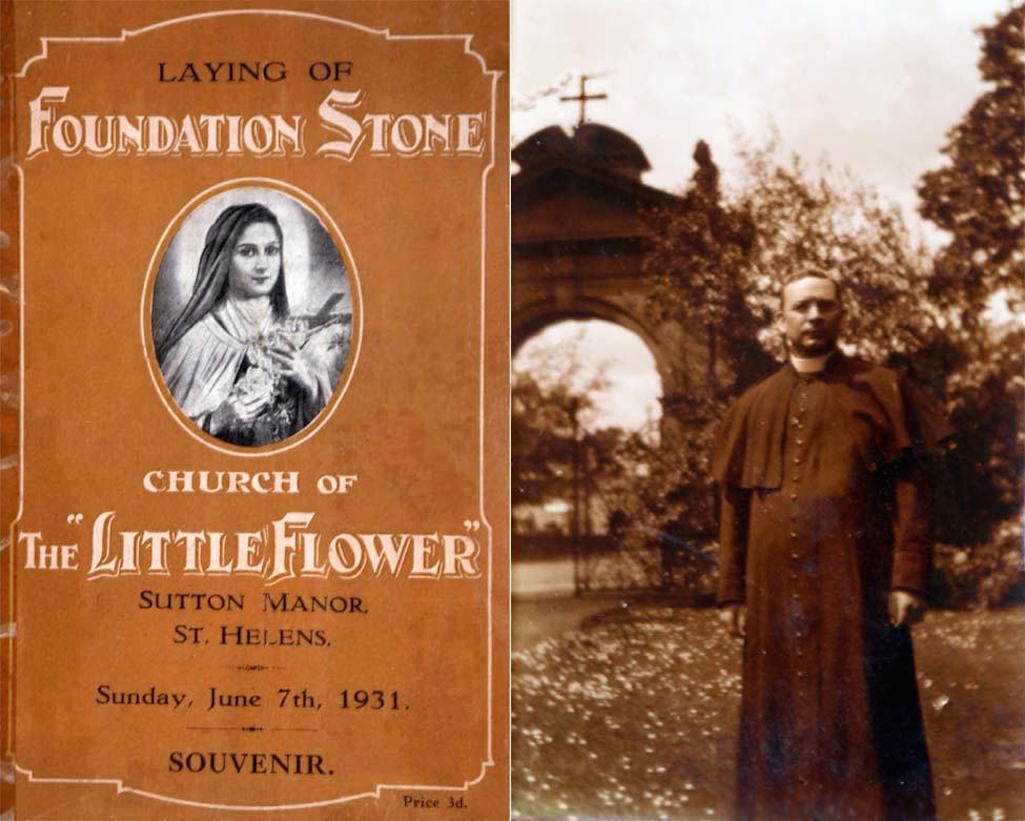
Left: the cover of the souvenir brochure for the foundation stone laying for the new church; Right: Father Ralph Holden

Souvenir brochure for the foundation stone laying and Father Ralph Holden

Souvenir brochure for the foundation stone laying and Father Ralph Holden
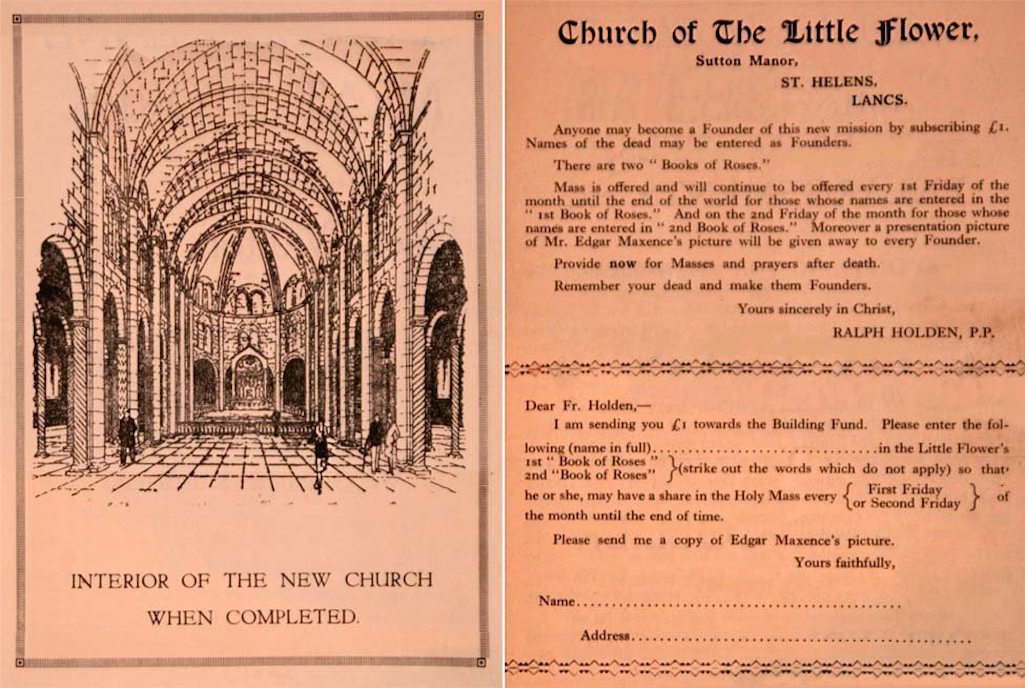
Two pages within the souvenir brochure commemorating the foundation stone laying for St.Theresa's church, Sutton Manor in 1931

From the St.Theresa's brochure commemorating the foundation stone laying

St.Theresa's brochure commemorating the church foundation stone laying

In the souvenir programme (which was priced at 3d) a further appeal was made for Founders who were willing to pay a pound to help fund the new church. In return names of all the contributors would be entered in one of two Books of Roses and all founders were promised a print of a portrait of St. Theresa that had been painted by the French Symbolist artist Edgar Maxence.
A so-called St. Theresa 'Cinderella' stamp was also made available as a souvenir to commemorate the foundation stone laying. Purchasers would not, however, have been able to use the Sutton Manor stamp to post their letters.
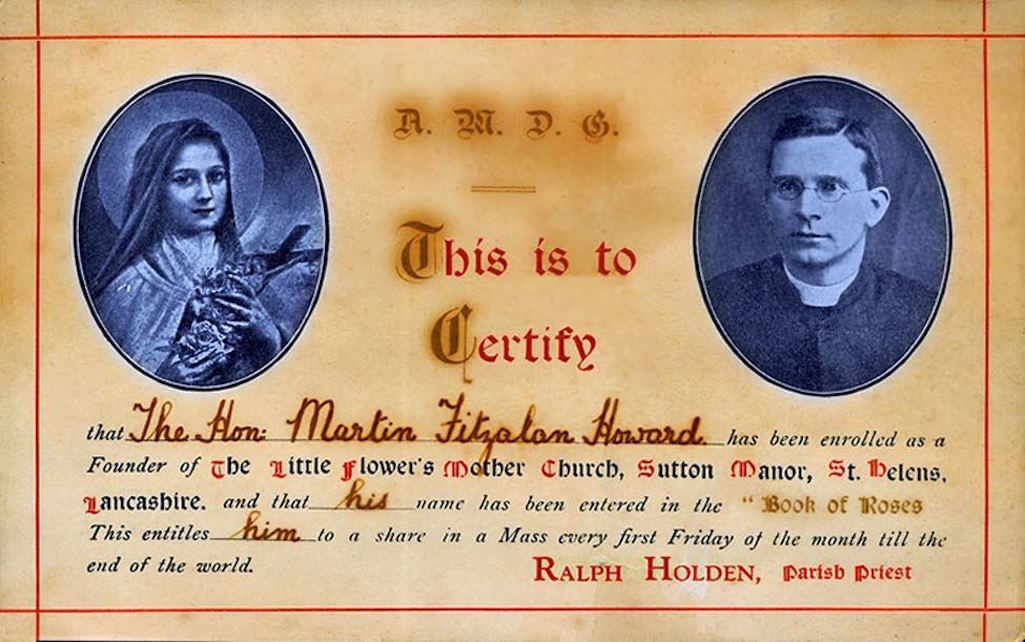
St.Theresa's Founder's Certificate awarded to donors to the new church - contributed by Rev. David Green

St.Theresa's Founder's Certificate awarded to donors to the new church

St.Theresa's Founder's Certificate
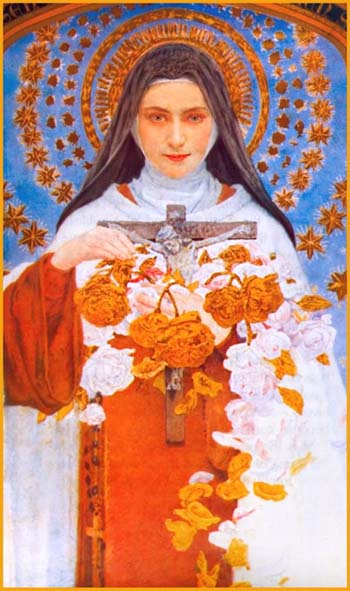
How much he donated isn't known but the wealthy nobleman, who became Lord Fitzalan-Howard, took part in many ecumenical projects and managed his family's Carlton Towers estate in North Yorkshire. The certificate was curiously discovered by Anglican curate Rev. David Green in the loft of his new Vicarage in West Malling, Kent when he moved in during August 2011.
Progress in constructing the new church was painfully slow through problems in funding and sourcing of materials. The stone was sourced from a quarry in Rainhill and it's said that an accident in unloading some stone slabs in Sutton Manor led to a crane toppling onto the quarry owner's son. The young man was crushed to death and his heartbroken father sent no further stone.
With the outbreak of war work on the new church ceased. Leaving a half-built building open to the elements for a number of years led inevitably to much damage and the local community nicknamed it "the ruins". Building work eventually resumed after the cessation of hostilities and post-war shortages with a fire that struck the old church in 1950 probably concentrating minds. The story even appeared in The Times (16/8/1950):
Father Michael had been a curate at St. Theresa's for some years and it had been his first appointment since ordination. In January 1945 he had given the last rites to a pilot of a Lockheed Shooting Star that crashed in Sutton Manor. He was a member of an Irish family with a boxing tradition that had settled in this country. Indeed one brother ran the boxing club at Lowe House in St.Helens. Father Michael now became priest in charge with completion of the new church a top priority.
By this time it must have been appreciated that compromises needed to be made, as the grand designs of 1931 could not realistically be achieved. The cost was too much and its original purpose had been lost, as a basilica had been opened in St.Theresa's home town of Lisieux. This had been dedicated in 1937 by Cardinal Pacelli, who later became Pope Pius XII, and was consecrated in 1954. The French basilica seats 4,000 people and is a centre for pilgrims from all over the world.
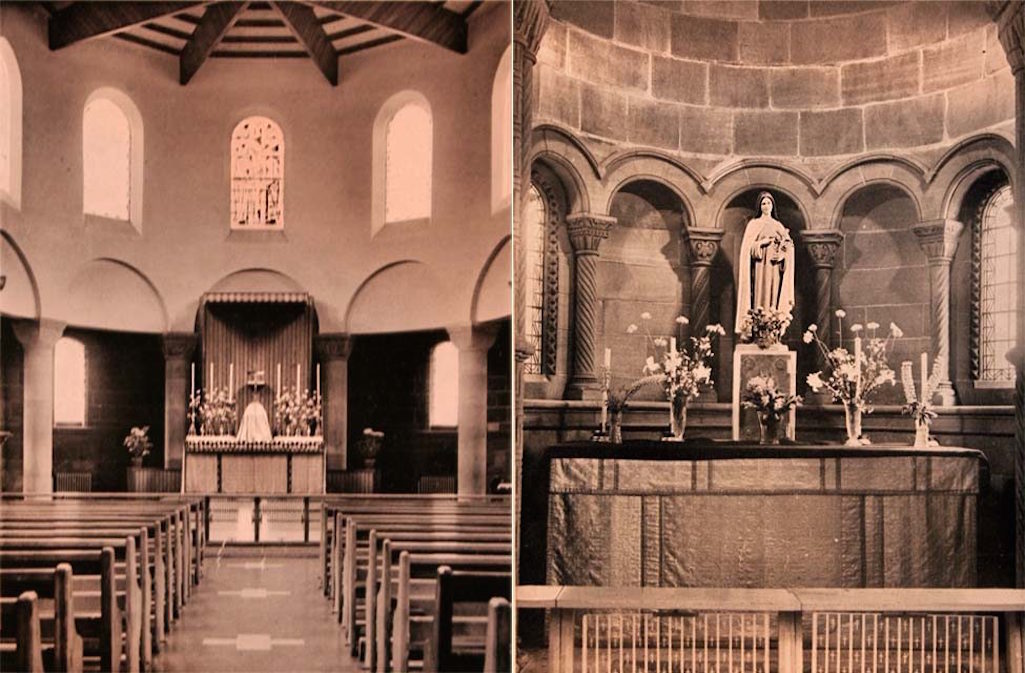
Two views of the interior of the newly-built St.Theresa's taken from a fundraising magazine published in 1962

Views of the interior of the newly-built St.Theresa's Church from about 1962

Interior of the new church c.1962
When Margaret O'Sullivan arrived in Sutton Manor in 1957 to live in the little convent on Gartons Lane, the young nun found the walls of the new church only halfway up. However the front arch of the church had been erected some years previously and on top stood a statue of St.Theresa. Margaret writes:
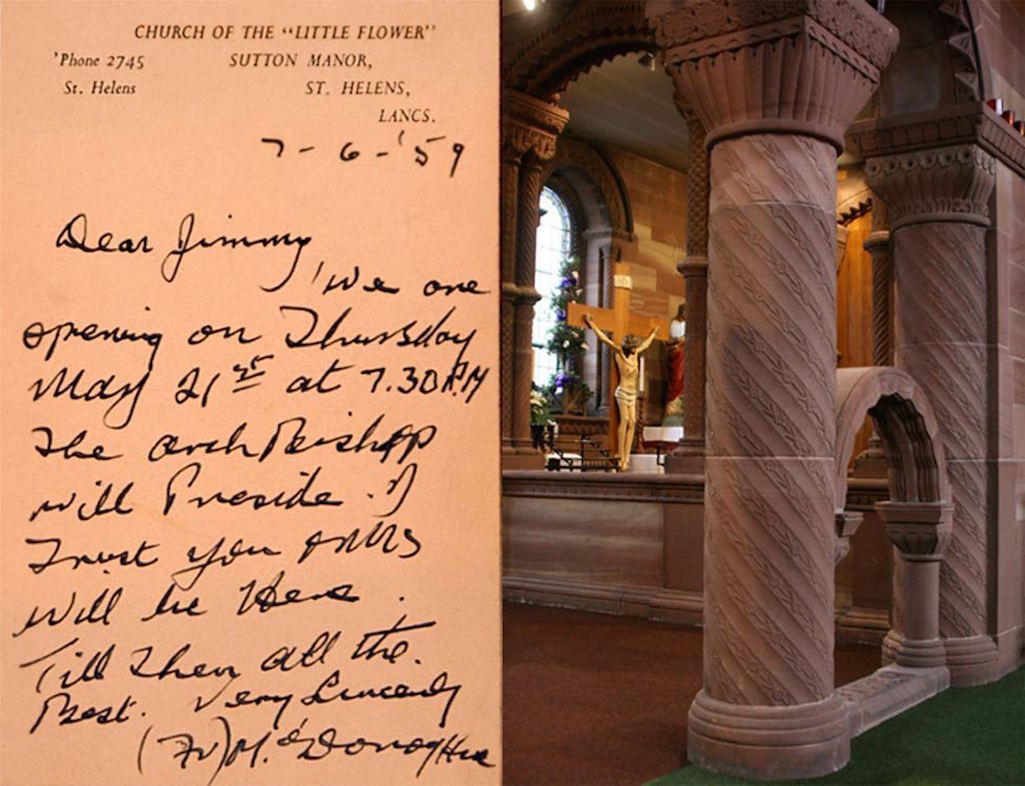
Left: Postcard despatched by Father Michael O'Donoghue; Right: beautifully carved pillar inside St.Theresa's church

Postcard sent by Father Michael O'Donoghue and beautifully carved pillar

Postcard sent by Fr. Michael O'Donoghue and carved church pillar
Father Michael's successor was Father Cornelius McEnroe who had the task of making the new church financially solvent. A special church magazine was published in 1962 which was devoted to appeals for donations. Father Cornelius wrote:
There are many, including Ron Padmore, who still recall the St.Theresa walking days from the 1960s that used to finish on Sutton Manor colliery's football pitch. "We got a bag of goodies and a bottle of pop; to us poor kids it was heaven!", writes Ron. Like other St. Theresa schoolkids, he would sometimes help in weeding the garden of the convent, which closed during the 1970s. The nuns taught at the school and during Ron's schooldays, the headmistress was Sister Agnes.
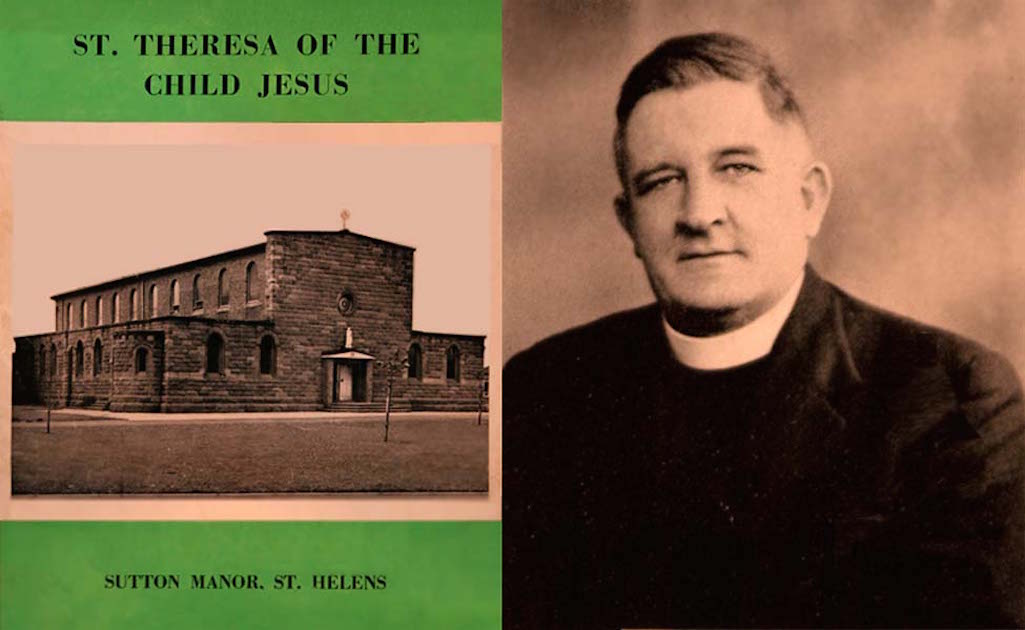
Left: Front cover of the St.Theresa's fundraising magazine from 1962; Right: Father Cornelius McEnroe

Cover of St.Theresa's fundraising magazine from 1962 and Fr. McEnroe

The cover of 1962 fundraising magazine and Father Cornelius McEnroe
St. Joseph's RC Church in Peasley Cross
The origins of St. Joseph's R.C. Church in Peasley Cross, go back to January 4th 1858 when the Passionist Fathers at Sutton Monastery opened a school in Appleton Street. The growth in the numbers of Roman Catholic children in the district in less than a decade had been so phenomenal that more school capacity was urgently needed. So Father Bernadine Carosi, rector of St. Anne’s, applied for a Government grant of £754 towards the cost of building a new school. This was reported to have been built in a ‘modern Italian style’ at a total expense of £2,000 and capable of accommodating between 400 - 500 children. It was named St. Joseph's in honour of Father Joseph Gasparini, who had pastoral responsibility for that part of the parish. The headmistress was Sister Frances de Sales Durie and Government inspector S. N. Stokes stated that she was the best teacher in the country.As the new school in Peasley Cross had been built with Government aid, it could not be used for church services as well. This presented a dilemma, as there was a pressing need for more church accommodation in the district. So fundraising began to build a hall capable of accommodating almost 1,000 people, where church services could be held. This opened in Langtree Street (which became Jackson Street) on January 8th 1862 under the name of St. Joseph’s Lecture Hall. Permission was subsequently given by Bishop Goss of Liverpool for Mass to be celebrated in the hall and by January 1863 there were two Sunday Masses celebrated at 8am and 11:30am, with Benediction at 3pm.
The estimated cost of St. Joseph’s Lecture Hall had been £520, but the final amount was much higher at £685 17s. From mid-August 1864 the new Rector of St. Anne’s, Father Ignatious Spencer, spent six weeks on the road attempting to obtain the additional funds. He’d successfully raised about £100 but succumbed to a heart attack in the village of Carstairs near Lanark.
During the evening of April 19th 1869 what was described as a "committee of the inhabitants of Peasley Cross" made a presentation to their pastor at St Joseph's RC School. The Rev. Fr. Nicholas was handed a watch and a "purse of gold" as a "testimonial of the high esteem in which he is held". The event was held in the church's boys' school and the St Helens Newspaper also commented that the "proceedings throughout were endorsed by the enthusiastic approval of a crammed house."
For two nights from November 15th 1869 'The Foundling of Sebastopol' was presented at St Joseph's School. Twelve young ladies performed all the acting and the St Helens Newspaper in its review of the first night praised the costumes and said: "The piece throughout was tolerably well sustained." Between the scenes the choir of St Joseph's and a number of vocalists performed a programme of music to a full house.
The Roman Catholic population of Peasley Cross was expanding rapidly and by the mid-1870s numbered about 1,200, including children. The Passionists found the additional workload within buildings that had become dilapidated and inadequate too great and on October 1st 1875 they pulled out of Peasley Cross.
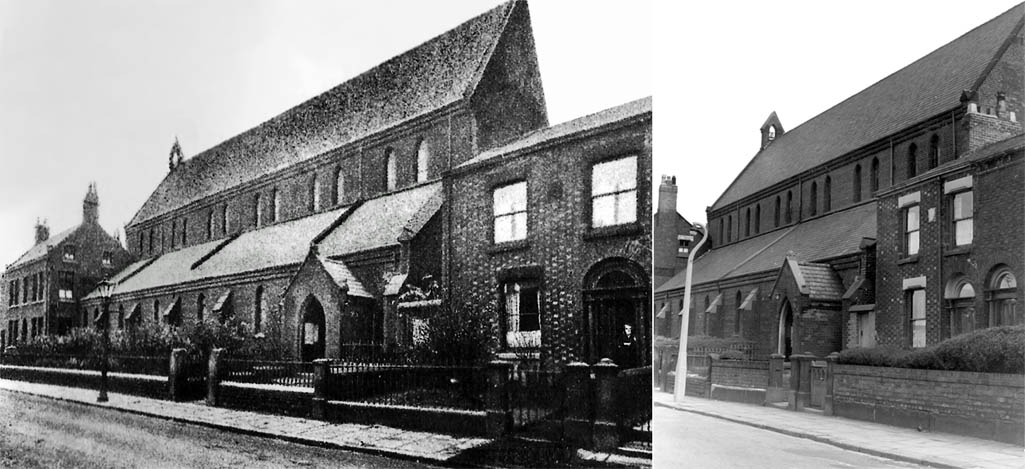
Two views of St. Joseph's from early in the 20th century and 1960 - note the gas light has been replaced by electric light

Two views of St. Joseph's from early in the 20th century and 1960
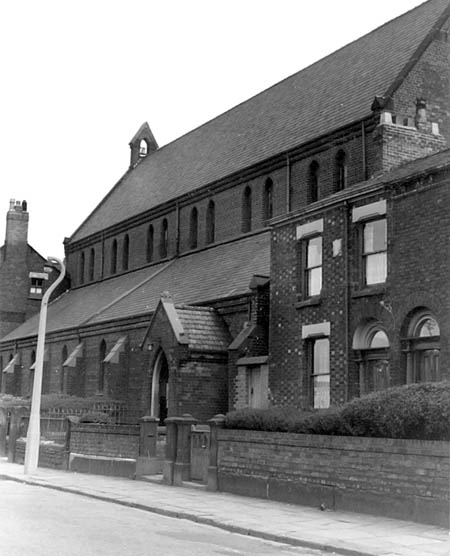
St.Joseph's RC Church, Peasley Cross
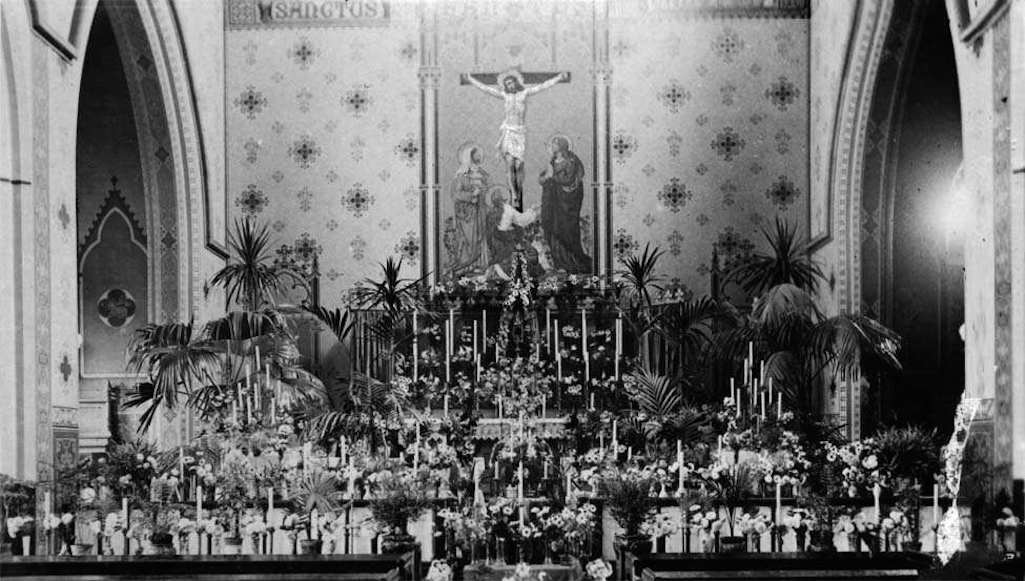
A picture postcard of St. Joseph's Roman Catholic Church in Peasley Cross, St.Helens c.1910

St. Joseph's Roman Catholic Church in Peasley Cross c.1910

St. Joseph's Roman Catholic Church
The cost of construction plunged the mission into considerable debt, which rector Fr. James Heyes considerably reduced during his tenure. He departed in January 1898 and was replaced by Fr. John Barry who left in September 1900 to take charge of a new mission at Barrow-in-Furness, before returning to St.Helens. Fr. Richard Ryan was listed as priest in the 1901 census, living in the Sutton Road Presbytery. Father Patrick Joseph Coffey was another popular priest at St. Joseph's, having previously been Chaplain to the Queen of Portugal.
Another early priest was Father Melia, a friend of Captain Michael Hughes of Sherdley Hall, who campaigned with him as Regimental Chaplain during the Boer War. Between the two world wars, Fr. Hugh McGarry served as assistant priest at St. Joseph’s for 18 years. There was also Ernest Daly, who was inducted as Rector on September 28th 1941, after previously being a professor at Castlehead College in Grange-over-Sands for twelve years.
Annual processions and field days in Sherdley Park first began in 1916. Describing the twenty-fourth such event in 1939, the St.Helens Reporter said:



